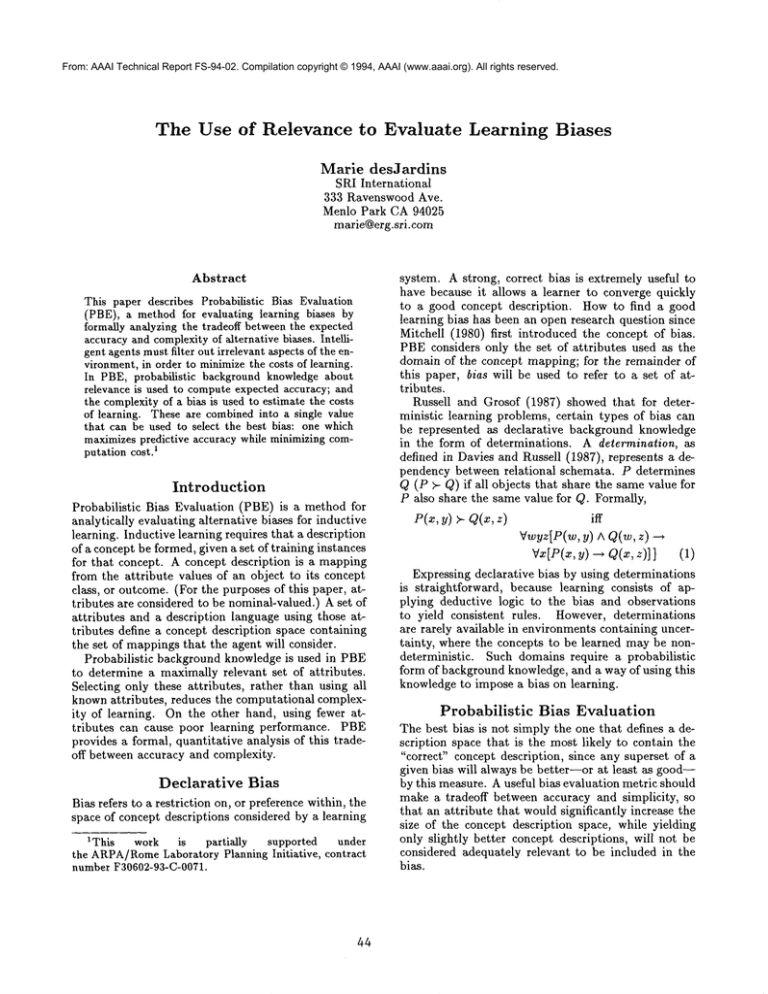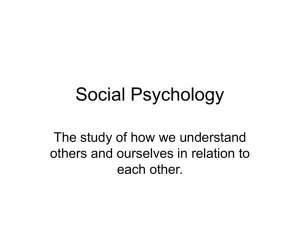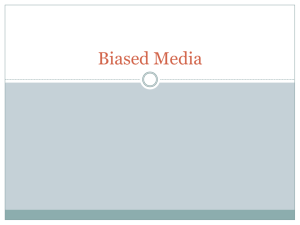
From: AAAI Technical Report FS-94-02. Compilation copyright © 1994, AAAI (www.aaai.org). All rights reserved.
The Use of Relevance
to Evaluate
Learning Biases
Marie desJardins
SRI International
333 Ravenswood Ave.
Menlo Park CA 94025
marie@erg.sri.com
Abstract
This paper describes Probabilistic Bias Evaluation
(PBE), a method for evaluating learning biases
formally analyzing the tradeoff betweenthe expected
accuracyand complexityof alternative biases. Intelligent agents mustfilter out irrelevant aspects of the environment, in orderto minimizethe costs of learning.
In PBE, probabilistic background knowledge about
relevance is used to computeexpected accuracy; and
the complexityof a bias is used to estimate the costs
of learning. These are combinedinto a single value
that can be used to select the best bias: one which
maximizespredictive accuracy while minimizing com1putation cost.
Introduction
Probabilistic Bias Evaluation (PBE) is a method for
analytically evaluating alternative biases for inductive
learning. Inductive learning requires that a description
of a concept be formed, given a set of training instances
for that concept. A concept description is a mapping
from the attribute values of an object to its concept
class, or outcome. (For the purposes of this paper, attributes are considered to be nominal-valued.) A set of
attributes and a description language using those attributes define a concept description space containing
the set of mappingsthat the agent will consider.
Probabilistic background knowledge is used in PBE
to determine a maximally relevant set of attributes.
Selecting only these attributes, rather than using M1
knownattributes, reduces the computational complexity of learning. On the other hand, using fewer attributes can cause poor learning performance. PBE
provides a formal, quantitative analysis of this tradeoff between accuracy and complexity.
Declarative
Bias
Bias refers to a restriction on, or preference within, the
space of concept descriptions considered by a learning
1 This
work is
partially
supported
under
the ARPA/Rome
Laboratory Planning Initiative, contract
number F30602-93-C-0071.
44
system. A strong, correct bias is extremely useful to
have because it allows a learner to converge quickly
to a good concept description.
How to find a good
learning bias has been an open research question since
Mitchell (1980) first introduced the concept of bias.
PBEconsiders only the set of attributes used as the
domain of the concept mapping; for the remainder of
this paper, bias will be used to refer to a set of attributes.
Russell and Grosof (1987) showed that for deterministic learning problems, certain types of bias can
be represented as declarative background knowledge
in the form of determinations. A determination, as
defined in Davies and Russell (1987), represents a dependency between relational schemata. P determines
Q (P ~- Q) if all objects that share the same value for
P also share the same value for Q. Formally,
P(x, y) ~- Q(x,
iff
Vwyz[P(w, y) A Q(w, z)
Vx[P(x, y) --* Q(x, z)]] (1)
Expressing declarative bias by using determinations
is straightforward, because learning consists of applying deductive logic to the bias and observations
to yield consistent rules. However, determinations
are rarely available in environments containing uncertainty, where the concepts to be learned may be nondeterministic. Such domains require a probabilistic
form of background knowledge, and a way of using this
knowledge to impose a bias on learning.
Probabilistic
Bias Evaluation
The best bias is not simply the one that defines a description space that is the most likely to contain the
"correct" concept description, since any superset of a
given bias will always be better--or at least as good-by this measure. A useful bias evaluation metric should
make a tradeoff between accuracy and simplicity, so
that an attribute that wouldsignificantly increase the
size of the concept description space, while yielding
only slightly better concept descriptions, will not be
considered adequately relevant to be included in the
bias.
The consequences of selecting a larger description
space are twofold. First, it will take more observations to converge on a good concept description. Second, searching a larger space takes more computational
time for each observation. The impact on the system’s
overall performance depends on how much the agent
discounts future rewards and on the cost of time in the
environment.
In this paper, time should be taken to refer to the
number of observations made, unless otherwise indicated. The analysis in PBE only considers the number of observations, not the computational time per
observation. However, these measures are related in
that they both depend on the size of the bias; thus,
computational time per observation will be indirectly
minimized.
The value that PBEassigns to each potential bias is
a measure of that bias’s expected behavior in the long
run. The bias value is the expected discounted future
accuracy of the predictions that would be made if the
bias were used for learning. Uniformities, which represent probabilistic knowledgeabout the distribution of
outcomes (O) given biases, or attribute sets (A),
used to derive the expected accuracy of the best concept description. This expected accuracy is combined
with a learning curve, yielding the expected accuracy
of concept descriptions over time. A time-preference
function is then used to find the overall expected discounted accuracy, which is the value of the bias. The
steps in this process are described in the following sections. A more detailed description of PBEcan be found
in desJardins (1994).
Probabilistic
Background
Knowledge
Determinations are weak knowledge, in that they do
not specify what the function mapping the inputs P
to the output Q is, only that one exists. So, for
example, knowing that Species(x,s)
~- Color(x,e)
does not allow one to predict the color of an individual of a previously unobserved species. But after observing one individual of species sl whose color
is known to be cl, one can immediately form a rule
that says Vx[Species(x,sl) --+ Color(x, cl)]. The latter
sort of rules--which enable individual predictions to
be made--will be referred to as strong knowledge.
Probabilistic background knowledge about relevance
is represented in PBEby using a form of weak knowledge called uniformities, which are a probabilistic version of determinations. U(OIA) (read "the uniformity
of O given A") is the probability that two random individuals that have the same values of the attributes A
will have the same value of the outcome O. Roughly,
U(OIA) is the degree to which O can be predicted,
given A. Like a determination, U(OIA) does not specify what the most commonvalue of O will be for any
given value of A. Formally,
U(OIA) = P(O(x) = O(y)lA(x ) = A(y))
(2)
Since a uniformity is simply a probability statement
about two independent random variables, x and y, a
system can learn and reason with uniformities as it
would with other forms of probabilistic knowledge. Initial uniformities are provided by the system designer or
by domain experts. The initial uniformities can be updated as the system acquires experience, and new uniformities can be learned by generalizing strong knowledge (Russell 1986).
In our framework, then, relevance is a probabilistic
notion. Specifically, an attribute or set of attributes
A is relevant for predicting the value of an output attribute O if it increases the marginal uniformity of O:
i.e., if
U(OIA) > U(O)
(3)
Note, however, that we are not just interested in choosing all relevant attributes, but the attributes that are
sufficiently relevant to be worth exploring, given the
costs of using those attributes for learning. The goal
of the PBE method is to provide a formal framework
for makingthis tradeoff.
Expected
Accuracy
To find the expected accuracy of predictions over time,
PBEfirst computes the expected accuracy of the best
concept description in the space defined by A. A simple
prediction task is assumed: every time a new example
(specifying values of A) is observed, the agent must
predict a value of O. If the most likely outcome is
always predicted (maximizing expected accuracy), the
expected accuracy of the best concept description is 15,
as given below.
The distribution of O, given A, is assumedto satisfy
the following two conditions:
1. The distribution is unimodal; that is, for each value
of A, there is one value of O, 5, that occurs most
often.
2. The other values of O occur equally often.
Suppose that O can take on n different values,
ol,...,o,~.
Assumption 1 says that given A, some 5
has the highest probability. Without loss of generality,
assumethat this is ol; its probability is/~:
P(O(x) = 011A) = ifi
(4)
Assumption 2 says that the remaining values of O
have equal probability. If there are n values of O,
P(O(x) = A) = n -
i=2,...,n
The definition of uniformity (Equation 2) states that
U(OIA) = P(O(x) = O(y)lA(x ) = A(y))
(6)
Substituting the probabilities from Equations 4 and 5,
and solving for/~ in terms of U(OIA), gives
= 1 + x/l-
n + n(nn
1)U(OI A) (7)
in a dynamic environment is 7t, based on a constant
discount rate 7, close to 1. Intuitively, using T(t) = t
means that accurate predictions in the distant future
are exponentially less important than near-term accuracy; but any correct prediction, no matter how distant, has some positive value. The closer 7 is to 1,
the more heavily long-term accuracy is counted. The
value of 7 will depend on the particular environment in
which the agent finds itself, and should be determined
experimentally.
Learning
Curves
Results from computational learning theory suggest
that the number of examples rh needed to learn a con¢ept is proportional to the Vapnik-Chervonenkis(V-C)
dimension of the bias (Blumer el al. 1986). In other
words, rh = cd, where d is the V-C dimension of the
bias, and c is a constant that depends on the error
rate. (For any particular learning algorithm, c is best
approximated empirically.)
The V-C dimension d for a decision tree, for example, is equal to the size of the space of possible examples, and
rh = cd = c ~I ni
Expected
Value of Biases
Combiningthe bias’s accuracy over time with the timepreference function q’(t), and integrating over time,
yield a general equation for the value of a bias:
(8)
i=1
where a is the numberof attributes in the bias, and ni
is the numberof values of attribute i.
This paper makes the simplifying assumption that
prior to finding the best concept description (t < rh),
predictions are no better than random guessing; after
this, they are as good as they are expected to get (i.e.,
the probability of a correct prediction is/~). Then the
accuracy of predictions as a function of time will be
q(t)=
ift<rh
i~ ±otherwise.
V =
q(t) T(t)
(10)
Using the simplified learning curve from Equation 9
and letting rh = cd and T(t) = 7t gives
V =
caTt
ffl --dr
n
t~dt
7
+f~
c<’
r->,’
1
= tn-f~n 7J 1 ÷ [lnTJ cd
(9)
1[ i
The actual learning curve will, of course, be
smoother; however, for relatively small, simple concept description spaces, this curve appears to be a
reasonable approximation. For more accurate results,
though, a better learning curve will be needed; unless results from computational learning theory can be
applied, a learning curve should be approximated empirically.
= ln7 7~d(/~--
(11)
d
)+
(12)
(13)
Notice that 7 and n are constant for a given learning
task; therefore, the only term that will differ among
candidate biases is 7cd(15- 1/n). Intuitively, if 7 is
large, so that the agent is willing to wait for accurate
predictions, d has less influence on the value (in the
extreme case, 7 = 1 and 7cd = 1, regardless of d).
As/~ grows, the bias becomesmore predictive, and the
value of the bias increases.
Time Preference
Functions
The effect of the passage of time on the value of predictions depends on a variety of factors, including the
amount of computation time available, what the prediction task is, the cost of makingerrors, the life expectancy of the agent, how fast the environment is
changing, and how many other tasks need to be accomplished simultaneously with this learning task.
The effects of these various factors are modeled in
PBE with a time-preference
function T(t). Timepreference functions are used in decision analysis
(Holtzman 1989) to indicate the degree to which the
importance of reward changes over time (i.e., the degree of discounting of future rewards). If an intelligent
agent’s prediction task involves making a single prediction at time to, for example, only the accuracy of
the agent’s prediction at that momentmatters: earlier
and later performance is irrelevant. In this case, the
time-preference function is zero at all points except for
a spike at time to.
A reasonable time-preference function for a simple
autonomous agent constantly performing predictions
Results
The effects of the cost associated with larger attribute
sets were measured using ID*, a probabilistic, incremental version of ID3 based on Quinlan (1986) and
Utgoff (1988). (ID* and the procedure used for these
tests are described in detail by desJardins [1992].) We
ran ID* in a synthetic learning domain, using various
subsets of the full attribute set as the learning bias;
the results are summarizedhere.
In each test run, 100 training examples were generated, and ID* was used to build four sets of decision
trees, with different subsets of the attributes. The average predictive quality n (number of test examples
classified correctly) is shownas a function of the number of training examples seen in Figure 1. (The attribute names are arbitrary and used only to aid in
the exposition.)
Figure 2 shows the expected accuracy p (computed
from the uniformities for the synthetic domain); the
expected number of correct predictions on a test set
46
The relative bias values for the domain are shown
in Figure 3. Location is the best choice unless 7 is
very high (location and shape outperform location only
when 7 is around 0.999). Using all of the attributes is
not worthwhile unless 7 is extremely close to 1.
4O
35
,. "#../’~---.’
3O
25
20
Conclusions
In realistic learning domains, there will be large numbers of irrelevant and marginally relevant attributes.
Intelligent agents must filter out the aspects of the environment that are not important for the learning task
at hand, and they must do this in a way that is sensitive to the context of learning. PBEprovides a formal
frameworkfor evaluating and selecting appropriate and
useful learning biases.
--~/~,
~--’~,,,\_~,.~
...........
15
10
Location,.ancl~haptb.....
~AII attributbs -Texture only ---
,, /
/
5 ~/
°o 1’o 2’0
=
=
i
=
i
30
40
50
60
70
Numberof training examples
8~0
=
90 100
Figure 1: Results of learning with four different biases
Attributes
All
Location
Location and shape
Texture
f)
.98
.90
.95
.50
E(n)
39.2
36.0
38.0
20.0
References
Blumer, A.; Ehrenfeucht, A.; Haussler, D.; and Warmuth, M. K. 1986. Classifying learnable geometric
concepts with the Vapnik-Chervonenkis dimension.
In Proc. 18th ACMSymposium on Theory of Computation, 273-282.
Davies, T., and Russell, S. 1987. A logical approach
to reasoning by analogy. Technical Report Note 385,
AI Center, SRI International.
desJardins,
M. 1992. PAGODA:A Model for Autonomous Learning in Probabilistic Domains. Ph.D.
Dissertation,
UCBerkeley. (Available as UCBCS
Dept. Technical Report 92/678).
desJardins, M. 1994. Evaluation of learning biases
using probabilistic
domain knowledge. In Computational Learning Theory and Natural Learning Systems, vol. 2. The MITPress. 95-112.
Holtzman, S. 1989. Intelligent
Decision Systems.
Addison-Wesley.
Mitchell, T. 1980. The need for biases in learning generalizations.
Technical Report CBM-TR117, Rutgers
University.
Quinlan, R. 1986. The effect of noise on concept learning. In Michalski, R.; Carbonell, J.; and Mitchell, T.,
eds., Machine Learning II. Morgan Kaufman. 149166.
Russell, S. J., and Grosof, B. N. 1987. A declarative
approach to bias in concept learning. In AAAI, 505510.
Russell, S. J. 1986. Analogical and Inductive Reasoning. Ph.D. Dissertation, Stanford University.
Utgoff, P. E. 1988. ID5: An incremental ID3. In
Machine Learning Conference, 107-120.
23.4
36.4
34.4
17.2
Figure 2: Expected and actual accuracy
of forty examples; and the actual number of correct
predictions on the test set after 100 training examples.
The smaller biases performed approximately as well
as expected, given the 100 training examples, but the
larger sample size needed for convergence in larger
spaces is clearly hindering the performance of the
learning algorithm. Presumably, given enough training examples (and computation time), the bias using
all of the attributes would converge on nearly perfect
prediction accuracy, but the marginal amount of accuracy gained over the predictions made by the smaller
biases is unlikely to be significant for manylearning
tasks. Considering that this is a relatively simple domain, the degree to which learning is impaired when
the full attribute set is used is rather surprising.
..................
;...."
0.g
............
................................
0.8
/.
//.’/
0.7
0.6
0.5
0.4
.----’"
.- ..........
Texture only
All attributes .....
0.3
.......................
.....................
0.2
0.9
DiSCountra~eg~O9scale)
0.99.99999
Figure 3: Relative bias values
47




